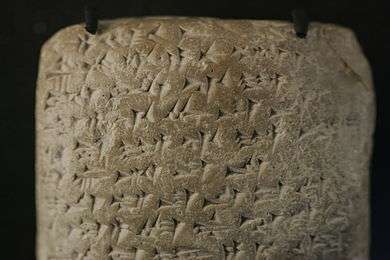Tu (cuneiform)
.jpg)

| Wikimedia Commons has media related to Tu (cuneiform). |
The cuneiform sign tu, and for TU-(the sumerogram, capital letter (majuscule), in the Hittite language and other cuneiform texts, is a common-use syllabic sign for "tu", and also with a syllabic use for "t", or "u". It is not a multi-use sign, with other alphabetic sub-varieties.
The Sumerian language version is similar to the usage in the Amarna letters, with the 3-horizontal strokes connecting the 4-angled wedges on the left, and connected to the vertical horizontal single-stroke, at right. Varieties exist: for example Amarna letter EA 271 shows 4-hortizontal long-strokes, with 2 short-strokes, between the two long ones, (see here, 2nd line from bottom (tablet Obverse): .
The Hittite language version of tu, (and ideogram TU) is identical in common form to the Sumerian.[1]
The composition of the sign is effectively the 4-wedge strokes at left, (being še (cuneiform)) connected to the rest of the cuneiform sign. Cuneiform še is also a common-use syllabic sign, with few subvarieties. (Two example angled-wedges: ![]()
Epic of Gilgamesh use
For the Epic of Gilgamesh, the following usage is found in Tablets I-XII: tu-(193), tú-(2), and TU-(9) times.[2] TU is used for the name of the 'king of Shuruppak'-(father of Utnapishtim), Ubara-Tutu, and it is spelled: mUBARA-dTU.TU.[3]
Two other uses of TU[4] in the Epic are as follows: "TU" is also the Akkadian language verb, erēbu, for English language "to enter", "to set", used in Tablet III and VII. For the sumerogram "TU.MUŠEN", for Akkadian summu, the English dove, it is used 2-times in the Gilgamesh flood myth-(Noah's Ark story), Tablet XI.
References
- ↑ Held, Schmalstieg, Gertz, 1987. Beginning Hittite. Warren H. Held, Jr, William R. Schmalstieg, Janet E. Gertz, c. 1987, Slavica Publishers, Inc. w/ Glossaries, Sign List, Indexes; Sign List, pp. 180-202, tu, no. 286, p. 200.
- ↑ Parpola, 197l. The Standard Babylonian Epic of Gilgamesh, Sign List, p. 155, Sign no. 058, tu.
- ↑ Parpola, 197l. The Standard Babylonian Epic of Gilgamesh, Index of Names, Personal Names, Ubaru-Tutu, p. 146.
- ↑ Parpola, 197l. The Standard Babylonian Epic of Gilgamesh, Logograms and Their Readings, pp. 117-8, p. 118, for TU & TU.MUŠEN..
- Held, Schmalstieg, Gertz, 1987. Beginning Hittite. Warren H. Held, Jr, William R. Schmalstieg, Janet E. Gertz, c. 1987, Slavica Publishers, Inc. w/ Glossaries, Sign List, Indexes, etc., 218 pages.
- Moran, William L. 1987, 1992. The Amarna Letters. Johns Hopkins University Press, 1987, 1992. 393 pages.(softcover, ISBN 0-8018-6715-0)
- Parpola, 197l. The Standard Babylonian Epic of Gilgamesh, Parpola, Simo, Neo-Assyrian Text Corpus Project, c 1997, Tablet I thru Tablet XII, Index of Names, Sign List, and Glossary-(pp. 119–145), 165 pages.
External links
- EA 271 Obverse, "tu", 2nd row from bottom
|
